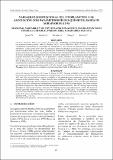Por favor, use este identificador para citar o enlazar este ítem:
https://hdl.handle.net/20.500.12958/3571Registro completo de metadatos
| Campo DC | Valor | Lengua/Idioma |
|---|---|---|
| dc.contributor.author | Jacobo, Nelly | - |
| dc.contributor.author | Sánchez, Sonia | - |
| dc.contributor.author | Bernales Jiménez, Avy | - |
| dc.contributor.author | Chang, Flor | - |
| dc.contributor.author | Flores Gonzáles, Georgina | - |
| dc.date.accessioned | 2021-07-16T04:43:05Z | - |
| dc.date.available | 2021-07-16T04:43:05Z | - |
| dc.date.issued | 2021-06 | - |
| dc.identifier.citation | Inf Inst Mar Perú 48(2), 2021, p. 173-185 | es_ES |
| dc.identifier.issn | 03787702 | - |
| dc.identifier.uri | https://hdl.handle.net/20.500.12958/3571 | - |
| dc.description.abstract | Se estudió la variabilidad estacional de la comunidad del fitoplancton y sus patrones de abundancia en la bahía de Miraflores - Callao, entre 2013 y 2014. Las muestras fueron recolectadas en marzo, julio y setiembre 2013 y marzo y octubre 2014 a dos niveles de profundidad. Diatomeas y fitoflagelados (ND) fueron los principales grupos dominantes en la bahía; seguidos por dinoflagelados, silicoflagelados y cocolitofóridos, estos últimos de menor importancia cuantitativa. Se observó un patrón estacional en la comunidad, siendo abundante el grupo funcional con estrategia “R” en primavera y verano, mientras que especies de estrategia “S” lo hicieron en invierno. Se evidenció una comunidad en activo crecimiento con bajos índices de diversidad (H’< 2,5 Bits.cel-1). Los cambios en la estructura comunitaria estuvieron relacionados principalmente con la concentración de fosfatos y silicatos en diatomeas y con cambios en la relación N:P en dinoflagelados, grupo que presentó sus mayores abundancias (49 x 104 cel.L-1) en el verano (TSMpromedio> 21 °C). | es_ES |
| dc.description.abstract | ABSTRACT: Between 2013 and 2014, we studied the seasonal variability of the phytoplankton community and its abundance patterns in the Miraflores Bay - Callao. Samples were collected in March, July, and September 2013 and March and October 2014 at two depth levels. Diatoms and phytoflagellates (ND) were the main dominant groups in the bay, followed by dinoflagellates, silicoflagellates, and coccolithophores, the latter of minor quantitative importance. We observed a seasonal pattern in the community. The “R” strategy species being abundant in spring and summer, while the “S” strategy species were abundant in winter. We found an actively growing community with low diversity indexes (H’< 2.5 Bits.cel-1). The changes in community structure were mainly related to the concentration of phosphates and silicates in diatoms and to changes in the N:P ratio in dinoflagellates, a group that presented its highest abundances (49 x 104 cel.L-1) in the summer (SSTmean> 21 °C). | - |
| dc.language.iso | spa | es_ES |
| dc.publisher | Instituto del Mar del Perú | es_ES |
| dc.relation.ispartofseries | Informe Imarpe;48(2), 2021 | - |
| dc.rights | info:eu-repo/semantics/openAccess | es_ES |
| dc.rights.uri | https://creativecommons.org/licenses/by/4.0/ | es_ES |
| dc.source | Instituto del Mar del Perú - IMARPE | es_ES |
| dc.source.uri | Repositorio Digital IMARPE | es_ES |
| dc.subject | Fitoplancton | es_ES |
| dc.subject | Diatomeas | es_ES |
| dc.subject | Fitoflagelados | es_ES |
| dc.subject | Lima - bahía de Miraflores | es_ES |
| dc.title | Variabilidad estacional del fitoplancton y su asociación con parámetros físicos-químicos, bahía de Miraflores (12°S) | es_ES |
| dc.title.alternative | Seasonal variability of phytoplankton and its association with physical-chemical parameters, Miraflores Bay (12°S) | es_ES |
| dc.type | info:eu-repo/semantics/article | es_ES |
| dc.publisher.country | Perú | es_ES |
| dc.subject.ocde | http://purl.org/pe-repo/ocde/ford#1.06.12 | es_ES |
| Aparece en las colecciones: | Informe vol. 48(2) 2021 | |
Ficheros en este ítem:
| Fichero | Descripción | Tamaño | Formato | |
|---|---|---|---|---|
| Informe 48-2 artículo1.pdf | 3,92 MB | Adobe PDF |  Visualizar/Abrir |
Este ítem está sujeto a una licencia Creative Commons Licencia Creative Commons

